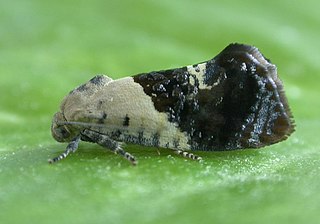
Hypertropha chlaenota is a species of moth of the family Depressariidae first described by Edward Meyrick in 1887. It is found in Australia, where it has been recorded from Victoria, Queensland, New South Wales, the Australian Capital Territory and South Australia.
Ephysteris semiophanes is a moth in the family Gelechiidae. It was described by Edward Meyrick in 1918. It is found in Sri Lanka.
Stenoma anetodes is a moth of the family Depressariidae. It is found in Guyana.
Stenoma platyterma is a moth of the family Depressariidae. It is found in Guyana.
Scorpiopsis pyrobola is a moth in the family Depressariidae. It was described by Edward Meyrick in 1887. It is found in Australia, where it has been recorded from Queensland and New South Wales.
Gonionota comastis is a moth in the family Depressariidae. It was described by Edward Meyrick in 1909. It is found in Peru and Colombia.
Gonionota oriphanta is a moth in the family Depressariidae. It was described by Edward Meyrick in 1928. It is found in Colombia.
Gonionota satrapis is a moth in the family Depressariidae. It was described by Edward Meyrick in 1914. It is found in Colombia.
Hypercallia chionastra is a moth in the family Depressariidae. It was described by Edward Meyrick in 1926. It is found in Colombia.
Hypercallia loxochorda is a moth in the family Depressariidae. It was described by Edward Meyrick in 1926. It is found in Colombia.
Hypercallia chionopis is a moth in the family Depressariidae. It was described by Edward Meyrick in 1916. It is found in French Guiana.
Hypercallia halobapta is a moth in the family Depressariidae. It was described by Edward Meyrick in 1930. It is found in Brazil.
Hypercallia alexandra is a moth in the family Depressariidae. It was described by Edward Meyrick in 1909. It is found in Peru.
Hypercallia cyathopa is a moth in the family Depressariidae. It was described by Edward Meyrick in 1913. It is found in Colombia.
Hypercallia miltopa is a moth in the family Depressariidae. It was described by Edward Meyrick in 1912. It is found in Panama and Colombia.
Hypercallia pyrarcha is a moth in the family Depressariidae. It was described by Edward Meyrick in 1910. It is found in India (Assam).
Hypercallia gnorisma is a moth in the family Depressariidae. It was described by Lord Walsingham in 1912. It is found in Mexico, Guatemala and Panama.
Stenoma picrantis is a moth in the family Depressariidae. It was described by Edward Meyrick in 1930. It is found in Pará, Brazil.
Imma lithosioides is a moth in the family Immidae. It was described by Frederic Moore in 1887. It is found in Sri Lanka.

Asaphodes prymnaea is a moth in the family Geometridae. It is endemic to New Zealand and can be found on the Mount Arthur tableland. It is common in limestone valleys. The female of the species is paler and has less distinctive markings than the male. Adults are on the wing in January and February.

